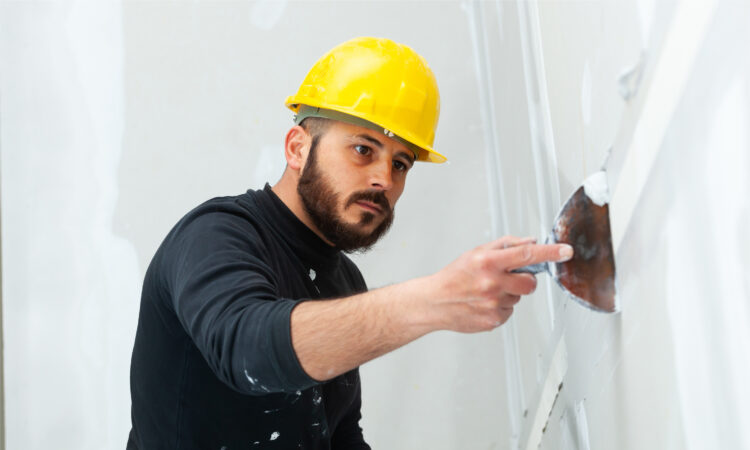Gypsum plastering has gained huge popularity in India and is replacing cement plasters and other traditional forms of plastering. With surging cement prices and wage rates, builders are increasingly shifting their preference to using gypsum plasters. More so, gypsum plasters are environment friendly and support construction of green buildings. As consumers are becoming more aware of the pollution from cement industries, gypsum plastering is evolving to be a sustainable alternative to cement plastering.
Given this, the blog aims to articulate important tips to achieve perfect gypsum plastering output and help builders and homeowners to save cost, time, and money in construction.
Prepare the surface well.
Before applying the gypsum plaster to the wall, always ensure that the surface is clean and free of impurities, dust, wallpaper, and debris. If you apply gypsum plaster on a wall with external impurities, the plaster may come off and may not stick properly. You can do so using a wire brush.
Clean tools and equipment
As much as it is important to have a clean surface, it is equally important to use clean bucket, tools and equipment for gypsum plastering. This ensures that plaster sticks well to the surface and does not fall off. The finish will also be smooth and crackless and so it can increase the appeal of your gypsum plastered surface.
Always mix the plaster well.
When you mix gypsum plaster with water always add the plaster to water and do not do it the other way round. Doing so helps avoid lumps while mixing and enhances the overall consistency of plastering. More importantly, you should mix the plaster well. Never over mix or under mix the plaster. If you do overmixing, you may not be able to achieve your intended consistency. And in case you undermix, the gypsum plaster may peel off separately and fall off from the wall or surface.
- Take water at the right temperature
When you mix the gypsum plaster, never take water at extreme temperatures. Do not mix gypsum plaster with water that is very hot or cold. Always use water at optimum temperature. If you use water that is extremely hot, then the plaster may become hard and this may not yield the desired consistency. On the other hand, if you take cold water for gypsum plaster preparation, it may be hard for you to mix the plaster. So, when you take water for gypsum plastering, do so at the room temperature to achieve the intended consistency.
Do not let the plaster in water for long periods of time
While you mix the plaster with water, make sure that you don’t let the plaster in water for so long. If you do so, the plaster may start to settle down in the bucket and you may find it hard to apply the plaster to the wall. So, once you achieve the right consistency, start applying on the wall immediately. Also, add enough plaster. Do not add too much as there are chances that the plaster may dry off and become hard in the bucket itself.
Do not apply high pressure while plastering
When you apply gypsum plaster to a wall, do it gently. Do not exercise high pressure. If you do so, the plaster may fall off after drying. You can use a trowel to apply the plaster evenly and at the right pressure. In case there are lumps and air pockets when you apply the gypsum plaster, use a trowel or plastering float to achieve the right consistency.
Do not take a long time to apply the plaster
Gypsum plaster dries quickly. So, it is important to apply the plaster right after mixing to achieve a smooth finish. Do not rework on the plaster after applying and when it starts to settle down. Do not try to get the smooth surface on the first coat itself. If you do so, it may fall off and always remember that you can iron out the imperfections in the further stages.
Let the plaster dry completely
Gypsum plaster takes 24-48 hours to settle down. Do not touch the plaster until it has dried completely. The surface becomes paint ready after 72 hours from the application of the plaster. So, until then avoid touching the surface as it may impact the consistency of the output. In case there are irregularities, you can try using a wet sponge to even out the surface and achieve perfect consistency in output.
Ensure that the environment is well ventilated
When you apply the gypsum plaster, ensure that the environment is well ventilated and there is good flow of air. Moisture buildup and retention can cause cracks in the plaster. So, doing gypsum plaster in a well-ventilated environment helps achieve the desired consistency.
Don’t stand below the trowel while plastering
While you do gypsum plastering for the ceiling, don’t stand below the trowel. The plaster may fall off into your eye and cause infection. Do not stand in the edges between ceiling and wall, as this may cause lumps on the corners.
Looking for gypsum plastering service?
Kanish Plasters is a leading gypsum plastering provider in India and has a strong presence in almost all major cities of India. It has always been rated a 5-star for its quality and timely delivery of services. The team has a checklist with 50-points to ensure that the outcome is consistent and matches the expectations of the builder and house owner.
If you are looking for a gypsum plastering service provider, write to us at [email protected].
Alternatively, you may call us at +91 9994500474.



